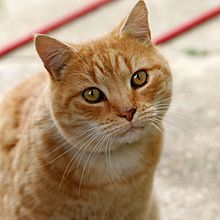Red hair

orangutans...


Red hair is a hair color shared by several species, among them humans, orangutans, domestic cats, cattle, and horses. It varies from a deep red through to bright copper.
Historical distribution
Red hair is most commonly found at both the west and eastern fringes of modern Europe. Although red hair in the human population is most commonly associated with those of Scandanavian descent, dark red or reddish-tinged hair can be found in a few other Caucasian populations. The Galatian invasion of 275 BC has resulted in a smattering of red hair in the population of modern-day Turkey, as well as some in Iran. The Berber Kabylie population of northern Algeria have occasional red heads.
Most redheads have blue eyes rather than green, and inherited the freckle gene from the Celtic tribes of the British Isles. Red hair is also sometimes found in other areas far from the fringes of Europe, such as Japan (1)
Boudica, the famous British queen of the Iceni, was said by the Greek historian Dio Cassius to: "be tall and terrifying in appearance ... a great mass of red hair fell over her shoulders". The Roman Tacitus commented on the: "red hair and large limbs of the inhabitants of Caledonia (Scotland)" (The Life of Agricola, Ch.11), which he linked with some red haired German/Belgic Gaulish tribes.
The modern British commonly believe that the cluster of red-heads in the British Isles, averaging 4%, can be associated with Pictish or Viking ancestry, and certainly Scotland has the highest proportion of red-heads of any country worldwide with 13% of the population having red hair. A further 40% of Scots carry the MC1R variant gene which results in red hair. Ireland has the second highest red-headed population in the world amounting to 10% of its inhabitants.
Oddly, there is a strong correlation - proven by an academic study of the British Isles - between the prevelance in an area of ginger cats and the proportion of that area's population who have red hair. Highland cattle are also notably ginger. Until the 19th century, black and brown forms of Highland cattle were more prevalent; however, Queen Victoria's love of the Highlands influenced her decree that Highland cattle be selectively bred for a toffee colored-coat. Highland cattle have been orange ever since.
It is estimated that between 2% - 3% of the United States population have red hair.
Biochemistry and genetics of red hair
The biochemistry of red hair, discovered only in 1997, appears to be associated with the melanocortin-1 receptor while the red color itself is produced by an iron compound. The recessive gene which gives people red hair, fair skin and light eyes appeared only 20,000 to 40,000 years ago.[1] MC1R is also associated with freckles, though it is not uncommon to see a redhead without freckles. All red heads are MC1R variants, and the prevalence of these alleles is highest in Celtic countries. Though originally the Celts were recorded as blonde, research tells us now that red hair was brought from the Vikings when settling into the British Isles cancelled out the recessive blonde gene and created the highest population of redheads in the world. MC1R is found on chromosome 16.
The genetics of red hair is now being uncovered, together with connections between red hair and melanoma, skin disorders in general, and different reactions to anaesthesia.[2] [3]
There is evidence for genetic linkage of eye color with other hair colors such as brown hair, but MC1R is not linked to eye color.[4]
The inheritence of red hair is close to what geneticists describe as an autosomal recessive mode of inheritance. This means that the parents of red-haired children may carry the gene for red hair but not have red hair themselves. It is this aspect of the inheritance of red hair that tends to lead to the various permutations of the milkman joke.
There is also evidence that red hair may be an example of incomplete dominance. This is similar to a simply recessive trait, but rather than not expressing at all when only one copy of the red hair allele is present, red hair blends with the other hair color, resulting in the very different types of red hair including strawberry blond (red/blonde) and auburn (red/brown).
One independent institute recently surmised that the number of red haired people in the world will continue to dwindle, and that the gene for red-colored hair may eventually become extinct by the end of 2100. However, this prediction is disputed.[5]
Kwashiorkor condition
In cases of severe malnutrition, normally dark human hair may turn red or blond. The condition, known as kwashiorkor, is a sign of critical starvation caused chiefly by protein deficiency, and is common during periods of famine.
Social implications
Queen Elizabeth I of England was a redhead, and during the Elizabethan era in England, red hair was fashionable. This was also the case during the rule of redhead Oliver Cromwell. Popular culture, particularly in the UK, sometimes discriminiates against those with the brighter types of red hair. It is often the case that ginger hair darkens considerably as children grown older. There is now an active RedAndProud society in the UK, aiming to counter such prejudices.
On the other hand, there are some individuals who describe themselves as redophiles or down with "scarlet fever". These people have a strong love for, and usually are sexually attracted to, redheads. As in any paraphilia, there are varying degrees to which a self-described redophile holds their desire. While some people favor the red hair solely for its exotic aesthetic pleasantness, others are more passionate and insist on giving their attentions only to natural redheads because they possess certain desired physical features such as pale skin that never tans, freckles, light pink areolae, and red pubic hair. Additionally, as mentioned above, the fading brightness of the hair color as someone ages implies that someone with red hair is younger, and, of course, youthfulness is generally considered a desirable sexual characteristic, particularly among women.
In addition to these physical traits, redophiles, as well as, to a certain degree, popular culture at large, also perceive redheads as being more passionate and adventurous than other people, both sexually and in a more general sense. This also extends to the stereotype that redheads have particularly "fiery" tempers, and are more easily angered than others. Jonathan Swift satirizes this stereotype in part four of Gulliver's Travels, A Voyage to the Country of the Houyhnhnms, when he writes: "It is observed that the red-haired of both sexes are more libidinous and mischievous than the rest, whom yet they much exceed in strength and activity." Swift goes on to write that: "...; neither was the hair of this brute [a Yahoo] of a red color (which might have been some excuse for an appetite a little irregular) but black as a sloe, ..."
Myths and stories related to red hair
- The Biblical mark of Cain is thought by some to have been red hair. Esau's entire body is supposed to have been covered with red hair. Also Judas Iscariot is sometimes supposed to have been redheaded. King David is also known for having red hair.
- Early artistic representations of Mary Magdalene usually depict her as having long flowing red hair, although a description of her hair color was never mentioned in the Bible, and it is possible the color is an effect caused by pigment degradation in the ancient paint. This myth is used as a plot device in the book The Da Vinci Code.
- Ancient Romans considered redheads to be unlucky.
- Ancient Egyptians associated both red-haired humans and red-colored animals with the god Set, considering them to be favored by the powerful and temperamental deity. Several pharaohs associated with Set are described as being red-headed.
- In both the Iliad and the Odyssey, the Greek king Menelaus is repeatedly described as having red hair.
- In Ancient Roman descriptions of the Picts describe them as almost all being red-headed.
Further reading
- Allen Sacharov. The Red Head Book (1985).
- Stephen Douglas. The Redhead Encyclopedia (1996).
- Uwe Ditz. Redheads (2000).
- Marion Roach. Roots of Desire: The Myth, Meaning and Sexual Power of Red Hair (2005).
- Liem EB et. al. Anesthetic requirement is increased in redheads. Anesthesiology. 2004 Aug;101(2):279-83.
- Box NF, Wyeth JR, O'Gorman LE, Martin NG, Sturm RA. Characterization of melanocyte stimulating hormone receptor variant alleles in twins with red hair. Hum Mol Genet. 1997 Oct;6(11):1891-7.
Notes
- Yamamoto M., and Neel J.V. "A note on red hair on the Island of Hirado, Japan". Jinrui Idengaku Zasshi. March 1967. 11 (4), pages 257-62.
See also
- Blonde
- Brunette
- List of famous redheads
- strawberry blonde
- auburn
- melanocytes
- melanin
- keratinocytes
- henna
- human skin color
External links
- OMIM entry on red hair
- The roots of red hair
- Red Hair genetics for non-specialists
- Melanocortin 1 receptor: What’s red got to do with it?
- The Melanocortin 1 Receptor (MC1R): More Than Just Red Hair
- Why is red hair with brown eyes so uncommon?
- Distribution of hair and eye color and sex in 592 statistics students. from Snee, R. D. (1974). Graphical display of two-way contingency tables. The American Statistician, 28, 9-12. (displayed as a table)
- A list of "famous redheads" at RedAndProud.com
- Ginger hair facts Trivia related to red hair
